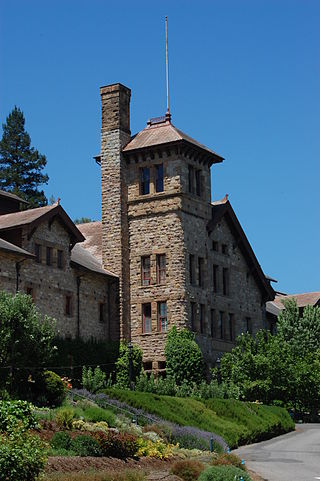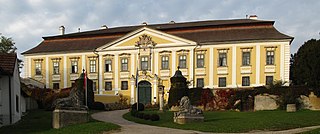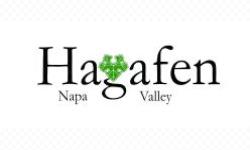Related Research Articles

Sauvignon blanc is a green-skinned grape variety that originates from the city of Bordeaux in France. The grape most likely gets its name from the French words sauvage ("wild") and blanc ("white") due to its early origins as an indigenous grape in South West France. It is possibly a descendant of Savagnin. Sauvignon blanc is planted in many of the world's wine regions, producing a crisp, dry, and refreshing white varietal wine. The grape is also a component of the famous dessert wines from Sauternes and Barsac. Sauvignon blanc is widely cultivated in France, Chile, Romania, Canada, Australia, New Zealand, South Africa, Bulgaria, the states of Oregon, Washington, and California in the US. Some New World Sauvignon blancs, particularly from California, may also be called "Fumé Blanc", a marketing term coined by Robert Mondavi in reference to Pouilly-Fumé.

Viognier is a white wine grape variety. It is the only permitted grape for the French wine Condrieu in the Rhône Valley.

Wine and food matching is the process of pairing food dishes with wine to enhance the dining experience. In many cultures, wine has had a long history of being a staple at the dinner table and in some ways both the winemaking and culinary traditions of a region will have evolved together over the years. Rather than following a set of rules, local cuisines were paired simply with local wines. The modern "art" of food pairings is a relatively recent phenomenon, fostering an industry of books and media with guidelines for pairings of particular foods and wine. In the restaurant industry, sommeliers are often present to make food pairing recommendations for the guest. The main concept behind pairings is that certain elements in both food and wine interact with each other, and thus finding the right combination of these elements will make the entire dining experience more enjoyable. However, taste and enjoyment are very subjective and what may be a "textbook perfect" pairing for one taster could be less enjoyable to another.

Châteauneuf-du-Pape is a French wine, an Appellation d'origine contrôlée (AOC) located around the village of Châteauneuf-du-Pape in the Rhône wine region in southeastern France. It is one of the most renowned appellations of the southern part in the Rhône Valley, and its vineyards are located around Châteauneuf-du-Pape and in neighboring villages, Bédarrides, Courthézon and Sorgues, between Avignon and Orange. They cover slightly more than 3,200 hectares or 7,900 acres (32 km2) and produce over 110,000 hectolitres of wine a year, more wine made in this one area of the southern Rhône than in all of the northern Rhône.

The Culinary Institute of America at Greystone is a branch campus of the private culinary college the Culinary Institute of America. The Greystone campus, located on State Route 29/128 in St. Helena, California, offers associate degrees and two certificate programs in culinary arts and baking and pastry arts. The CIA at Greystone and the Culinary Institute of America at Copia make up the school's California branch.
Carole P. Meredith is an American grape geneticist and was a professor at the Department of Viticulture and Enology of University of California, Davis.

Languedoc-Roussillon wine, including the vin de pays labeled Vin de Pays d'Oc, is produced in southern France. While "Languedoc" can refer to a specific historic region of France and Northern Catalonia, usage since the 20th century has primarily referred to the northern part of the Languedoc-Roussillon region of France, an area which spans the Mediterranean coastline from the French border with Spain to the region of Provence. The area has around 700,000 acres (2,800 km2) under vines and is the single biggest wine-producing region in the world, being responsible for more than a third of France's total wine production. In 2001, the region produced more wine than the United States.

Kermit Lynch is an American wine importer and author based in Berkeley, California. He is the author of Adventures on the Wine Route, which won the Veuve Clicquot Wine Book of the Year award, as well as Inspiring Thirst. He also co-owns Domaine Les Pallières in Gigondas along with the Brunier family of Domaine du Vieux Télégraphe in Châteauneuf-du-Pape.

Mark Stanford Oldman is an American entrepreneur, wine expert, and author of several books on wine. Founder of the wine school Bevinars.com, he has been described as "one of the wine world's great populizers" and "one of the wine world's great showmen." He is regularly named the "audience favorite" at major food and wine festivals and does private events for corporations and institutions. He also designed and teaches a course on entrepreneurship for Stanford University.

The use of wine tasting descriptors allows the taster to qualitatively relate the aromas and flavors that the taster experiences and can be used in assessing the overall quality of wine. Wine writers differentiate wine tasters from casual enthusiasts; tasters attempt to give an objective description of the wine's taste, casual enthusiasts appreciate wine but pause their examination sooner than tasters. The primary source of a person's ability to taste wine is derived from their olfactory senses. A taster's own personal experiences play a significant role in conceptualizing what they are tasting and attaching a description to that perception. The individual nature of tasting means that descriptors may be perceived differently among various tasters.

The harvesting of wine grapes (vintage) is one of the most crucial steps in the process of wine-making. The time of harvest is determined primarily by the ripeness of the grape as measured by sugar, acid and tannin levels with winemakers basing their decision to pick based on the style of wine they wish to produce. The weather can also shape the timetable of harvesting with the threat of heat, rain, hail, and frost which can damage the grapes and bring about various vine diseases. In addition to determining the time of the harvest, winemakers and vineyard owners must also determine whether to use hand pickers or mechanical harvesters. The harvest season typically falls between August & October in the Northern Hemisphere and February & April in the Southern Hemisphere. With various climate conditions, grape varieties, and wine styles the harvesting of grapes could happen in every month of the calendar year somewhere in the world. In the New World it is often referred to as the crush.

Quixote Winery is a boutique winery in the Stags Leap District of Napa Valley, California. The winery produces organic red wine in the premium segment, and also features unusual, eclectic architecture and label design.

California wine production has a rich viticulture history since 1680 when Spanish Jesuit missionaries planted Vitis vinifera vines native to the Mediterranean region in their established missions to produce wine for religious services. In the 1770s, Spanish missionaries continued the practice under the direction of the Father Junípero Serra who planted California's first vineyard at Mission San Juan Capistrano.
Dara Moskowitz Grumdahl is a magazine feature writer and a food and wine writer, based in Minneapolis, Minnesota.

Wine tasting is the sensory examination and evaluation of wine. While the practice of wine tasting is as ancient as its production, a more formalized methodology has slowly become established from the 14th century onward. Modern, professional wine tasters use a constantly evolving specialized terminology which is used to describe the range of perceived flavors, aromas and general characteristics of a wine. More informal, recreational tasting may use similar terminology, usually involving a much less analytical process for a more general, personal appreciation.

The aromas of wine are more diverse than its flavours. The human tongue is limited to the primary tastes perceived by taste receptors on the tongue – sourness, bitterness, saltiness, sweetness and savouriness. The wide array of fruit, earthy, leathery, floral, herbal, mineral, and woodsy flavour present in wine are derived from aroma notes sensed by the olfactory bulb. In wine tasting, wine is sometimes smelled before taking a sip in order to identify some components of the wine that may be present. Different terms are used to describe what is being smelled. The most basic term is aroma which generally refers to a "pleasant" smell as opposed to odour which refers to an unpleasant smell or possible wine fault. The term aroma may be further distinguished from bouquet which generally refers to the smells that arise from the chemical reactions of fermentation and aging of the wine.

An international variety is a grape variety that is widely planted in most of the major wine producing regions and has widespread appeal and consumer recognition. These are grapes that are highly likely to appear on wine labels as varietal wines and are often considered benchmarks for emerging wine industries. There is some criticism that the popularity of so-called international varieties comes at the price of a region's indigenous varieties. The majority of declared international varieties are French in origin, though in recent years the popularity of Spanish and Italian varietals has seen an increase in worldwide plantings and these may also be considered "international varieties".

Schloss Gobelsburg is a winery and castle in the Kamptal wine growing region in Lower Austria, some 50 miles to the north west of Vienna. The estate produces both red and white wines. Wine production on the estate dates to 1171; it is the oldest winery in the Danube region. The structure is a listed building.

Hagafen Cellars is a winery located in the Napa Valley. Founded in 1979, it was the first kosher winery in California, and is "the first of the upscale kosher brands." The winery is owned and operated by winemaker Ernie Weir and his wife, Irit Weir.
Julia Coney is an American journalist and wine writer who has advocated for diversity and inclusion in the industry. She wrote an essay about racism in the wine industry and created Black Wine Professionals, a database tool intended to increase diversity in the industry.
References
- 1 2 3 4 Terry McCarthy (2004-12-17). "Missionary of the vine". Time. Archived from the original on November 28, 2007. Retrieved 2021-05-19.
- 1 2 3 Jane Tunks (2006-12-29). "Wine educator keeps her roots close to the vine". San Francisco Chronicle. Retrieved 2021-05-19.
- ↑ Jonathan Reynolds (2002-09-29). "Que Syrah, Syrah". The New York Times. Retrieved 2021-05-19.
- ↑ S. Irene Virbila (2015-09-18). "Bestselling book The Wine Bible is updated: What's changed in 14 years?". Los Angeles Times. Retrieved 2021-06-02.
- ↑ "The Wine Bible, 3rd Edition". 16 January 2023.
- 1 2 Jackie Burrell (2020-10-31). "The Wine Bible's Karen MacNeil talks virtual tastings, wine glasses and WineSpeed". San Jose Mercury News. Retrieved 2021-06-02.
- ↑ Teague, Lettie (2015-12-03). "The Five Best Wine Books for Beginners". Wall Street Journal. ISSN 0099-9660 . Retrieved 2021-10-29.
- ↑ Heimoff, Steve, 'Q & A with Karen MacNeil'. Wine Enthusiast (July 18, 2007)
- ↑ Wine Business (March 29, 2010). Wine Expert and Author Karen MacNeil Launches New Brand Identity and Innovative Website
- ↑ "The Wine Bible's Karen MacNeil talks virtual tastings, wine glasses and WineSpeed". The Mercury News. 2020-10-31. Retrieved 2021-10-29.
- ↑ "Read Between The Wines". 29 November 2022.
- ↑ Gina King (2012-12-12). "Industry Insights: Interview with Karen MacNeil". Domaine Somm blog. Retrieved 2021-05-19.
- ↑ "Dennis P. Fife (1945-2016)". Napa Valley Register. 2016-06-06. Retrieved 2021-05-19.